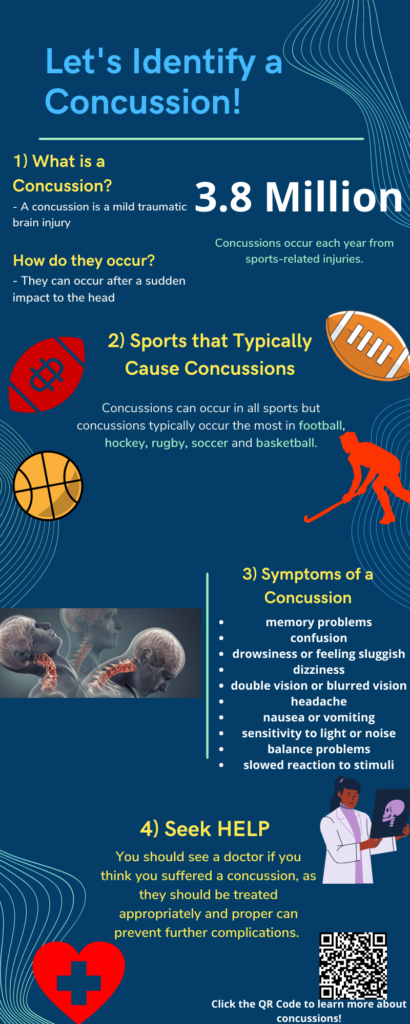Goal
Learners will be able to identify a concussion, typically caused by high-impact force to the head. Various sports will be used to examine examples of situations where dangerous head injuries may occur.
Learning Outcomes: By the end of this lesson, learners will be able to identify concussions, by applying the knowledge gained from the information presented in the infographic and video. More specially learners will be able to:
- Demonstrate the knowledge of what a concussion is by creating a Sketchnote identifying each of the major symptoms to look for.
- Describe what sports typically cause concussions by adding to the previous Sketchnote.
- Complete the summary quiz to demonstrate their application of the knowledge they have learned regarding concussions from the video and infographic.
- Create a final Sketchnote after reflecting after receiving feedback from the summary quiz to review concepts by describing and explaining the questions they got wrong, to further improve their ability to demonstrate their knowledge of the concussion-related information.
Prior Knowledge
- It may be beneficial if learners know the warning signs of concussion. The concussion protocol will familiarize the learner with the required steps to examine athletes for a head injury / concussion.
- Learners will need to know how to sketchnote in order to work through the activities.
Delivery
Infographic created using Canva:
- Identifying Concussions:
- A brief overview of concussions and how they occur
- The sports that typically cause concussions
- Symptoms of a concussion, to further aid in the identification of a concussion.
- When to seek help
Video creating using Screencastify
- Provide examples from high-impact sports to help the learner identify when a player needs to leave the game to be evaluated for a concussion:
- NFL blue tents as one example of the concussion protocol process.
- Steps of recovery from concussion diagnosis to being able to return to full game activities.
- Complete a Summary Quiz, created using Google Forms and create a final Sketchnote
- Learners will demonstrate their application of knowledge gained by answering quiz questions
- Creating a final sketchnote will allow the learner to create their own suggestions on the concussion protocol process of the NFL blue tents, and also identify questions they got wrong.
Evaluation
- Learners will be asked to create a final sketchnote to apply and describe their understanding of the concepts learned in the infographic and video.
- Learners will be required to take a quiz after viewing and understanding the infographic and video, which will indicate to them if they have understood the content, additionally they can also share their own thoughts regarding the topic.
After creating our lesson plan we developed the following multimedia content to achieve our goal:
First is our Inforgraphic!

- While constructing the infographic I followed several multimedia principles.
- Learner control principle – I decided to use this principle because the learners can read the information presented in the infographic at a pace that they are comfortable with.
- Signalling principle – This principle is applied as I included numbers next to each of the main topics, this number structure will allow the learner to understand the flow and structure of the information, thus allowing the learner to learn more efficiently.
- Segmenting principle – I separated the information into four sections which allows the learner to take a minute after they finish reading a section, and then reflect upon the topic they have just read.
- Coherence principle – I employed this principle as I believe it is important for learners to have a low cognitive load, therefore the information presented in each of the sections is relatively simple and concise, therefore easy to follow.
Next, our instructional video presentation:
https://connorbaldwin28.opened.ca/wp-admin/admin-ajax.php?action=h5p_embed&id=4
Finally, the summary quiz: https://docs.google.com/forms/d/e/1FAIpQLSc8zsa5PIUNqHZXn8H9culotnhlE30hx8IT1Ie-F_ljVh7yLA/viewform?usp=sf_link
Instructional Video:
- Our goal is to teach the learner how to identify a concussion. The video includes the following principles.
- I followed the split-attention principle by keeping the summary quiz separate from the video so learners could take time to reflect on the material before answering the questions.
- I followed the dual coding theory by using visual information (text and images) on the PowerPoint slides with commentary that expands on the ideas.
- The modality principle is observable in this video as the combination of graphics and narration which make it easier to follow.
- The personalization principle is followed by ensuring that the narration of the video was presented in a conversational style rather than formal.
- The coherence principle is used by excluding extraneous material that is not necessary to be printed on the PowerPoint slides but rather narrated.
- I followed the cognitive load theory by limiting the amount of information on each slide and I made sure to keep the embodiment principle in mind while I was recording the narration (not using my webcam).
- The multimedia principle was followed as people learn better from words and pictures instead of only words.
References
- Sources used to create the instructional video:
- Las Vegas Review Journal: https://www.reviewjournal.com/sports/nhl/heres-how-the-nhl-concussion-protocol-works-1953072/#:~:text=The%20NHL%2FNHLPA%20Concussion%20Evaluation,%2C%20identification%2C%20evaluation%20and%20management.&text=A%20player%20is%20required%20to,that%20an%20evaluation%20is%20necessary.
- IndyStar: https://www.indystar.com/story/sports/nfl/colts/2017/11/14/nfl-concussion-protocol-what-happens-those-blue-sideline-tents/861760001/
- Pride of Detroit: https://www.prideofdetroit.com/2019/10/9/20906590/explaining-nfls-5-step-concussion-protocol-tj-hockenson
- Sources used to create the infographic:
- Heathline: https://www.healthline.com/health/concussion#diagnosis
- Stanford News: https://news.stanford.edu/2018/10/19/concussion-hometop-hed-tk/
- Brainline: https://www.brainline.org/article/concussion-and-sports#:~:text=Concussions%20occur%20in%20all%20sports,%2C%20rugby%2C%20soccer%20and%20basketball.&text=The%20largest%20number%20of%20sports,bicycling%2C%20football%2C%20and%20basketball
- Other Images: Photo by Geoff Scott on UnSplash: https://unsplash.com/photos/8lUTnkZXZSA
Leave a Reply
You must be logged in to post a comment.